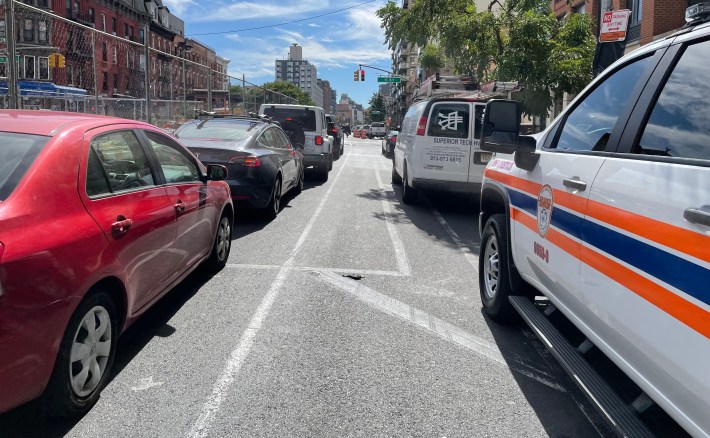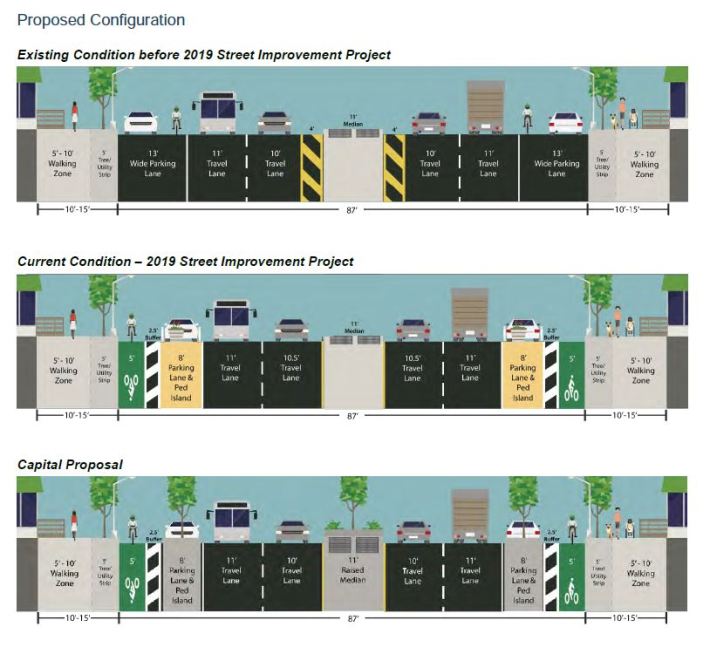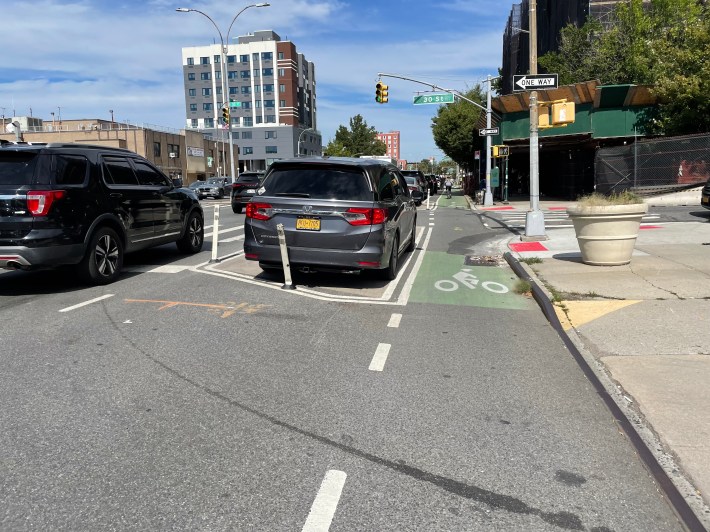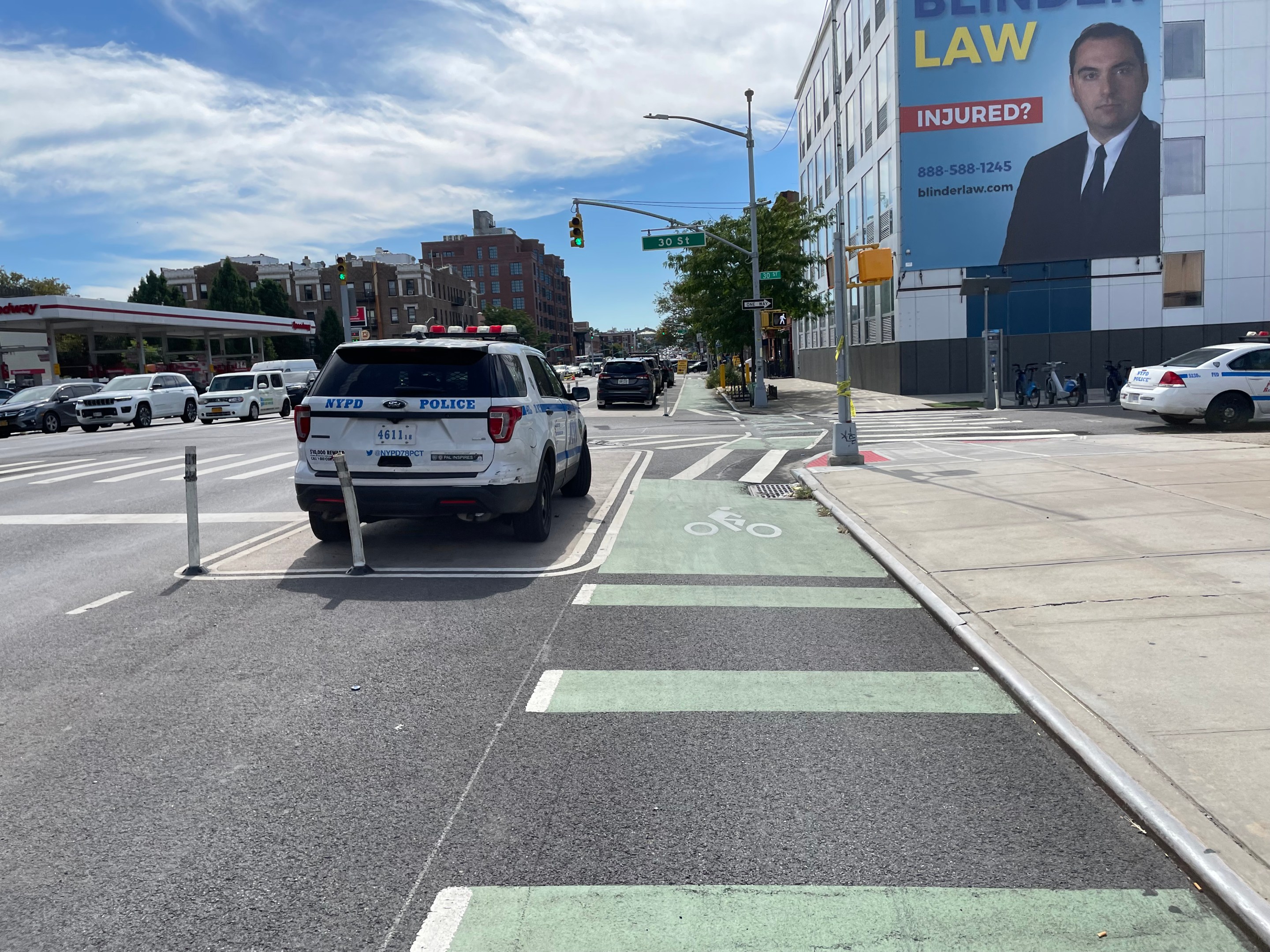It’s the never-ending capital project.
Cyclists in southern Brooklyn will have to keep waiting for relief from the continued construction on Fourth Avenue's two-part "Great Street" capital project, as Phase I, originally set to end in June, has now been pushed back at least another year, the Department of Transportation said in a presentation.
In a 2022 letter, the DOT said it would finish this phase of construction — bolstering medians and adding plantings — by June 2024. But at a Community Board 7 Transportation Committee meeting earlier this year, DOT casually mentioned a delay, saying the first phase has a new completion timeline: "in August 2025."
But "Phase II" — adding concrete to existing painted zones that are de facto parking spaces right now — won't begin until 2026. Cyclists worry that it will come with more rolling bike lane closures, but a Transportation Department spokesperson told Streetsblog that the lanes will remain open and functioning with temporary bike lanes where needed during the second phase.
If so, that's a change from what occurred during construction on the roadway’s median, where the DOT has been erasing the life-saving protected bike lane in three-block stretches, forcing cyclists into a lane with cars.

“You hit sections where DOT is doing the capital work on the median, and you're dealing with the situation where they’ve erased the bike lane to try to preserve two lanes of through traffic at all times. It can be a pretty jarring experience,” said John Tomac, the president of Bike South Brooklyn.
The three-mile, $60-million Vision Zero Great Streets Capital Project spans Fourth Avenue between Eighth and 64th streets through Park Slope, Gowanus, and Sunset Park. The project was first announced in 2017 [PDF], but was delayed in 2020. The Transportation Department and the Department of Design and Construction finally broke ground in 2021.

“The major bike and pedestrian improvements on Fourth Avenue will build on the success of DOT’s bike lanes with a full suite of capital upgrades — including concrete pedestrian islands, curb extensions, grade-separated bike lanes, and other enhancements — which will slow turning drivers and better protect everyone on the avenue,” said DOT spokesman Vin Barone.
Advocates have been fighting for a temporary bike lane since construction began, but the DOT admitted to putting cyclists in danger in favor of cars, telling Bike New York and Bike South Brooklyn that the agency would waive Local Law 124, which requires a temporary bike lane during construction. In a letter to the activists groups, DOT Commissioner Ydanis Rodriguez said that he couldn't provide safe routes for cyclists because “the approximately one-mile vehicle backups expected to occur from converting a traffic lane into a bike lane would introduce a significant number of turning conflicts at high-pedestrian-volume intersections by vehicles seeking a detour.”
Looks like @NYC_DOT has tacked on another year at least of its pointless & dangerous rolling suspension of the 4th Ave #bikenyc lane pic.twitter.com/XUNubc1VE1
— Bike New York (@bikenewyork) April 4, 2024
Activists remain angered by that letter, especially since it came as part of a larger project focused on pedestrian safety.
"The logic was terrible to begin with," said Bike New York's Director of Advocacy Jon Orcutt. "If the city had said, 'It'll be more convenient for our crews,' at least it would have been true."
As the construction persists, the two lanes of traffic almost always become one because of rampant illegal parking in the turning lane.
"We now have at least two years of empirical evidence that because people are parking it shrinks the avenue to one moving lane in each direction anyways," said Orcutt.
Last August, the local community board sent a detailed letter asking the DOT to complete the bike lane and install bollards on the pedestrian islands.
“The 'Great Streets' plan has been a project this community has been expecting, in some form, for more than 25 years,” reads the letter. “Our residents should not have to accept these unsafe conditions and poor aesthetics that other communities don't have to endure in order to have a truly 'Great Street' design.”
The department did not directly address the communities concerns, rather, it forwarded the letter to the Department of Design and Construction, which is managing the project's implementation. DDC responded only to the community’s concern about concrete matching and sloppy workmanship.
The Community Board’s transportation chair told Streetsblog that DOT has failed to take measures to discourage illegal parking on the pedestrian islands, while in other neighborhoods, the agency has added bike racks or cement blocks as a temporary measure.

"They can do it and they have done it in other communities," said the chair, Katherine Walsh. "In CB7, we're waiting for other things to happen and other communities are getting so much more. This, to us, comes back to an equity issue where it's like, we are one of the most heavily impacted communities from environmental pollution because of the Brooklyn-Queens Expressway, and yet we're getting a lack of engagement on making progress."
An agency spokesperson told Streetsblog that the DOT will look into additional treatments that may be needed in the interim.






